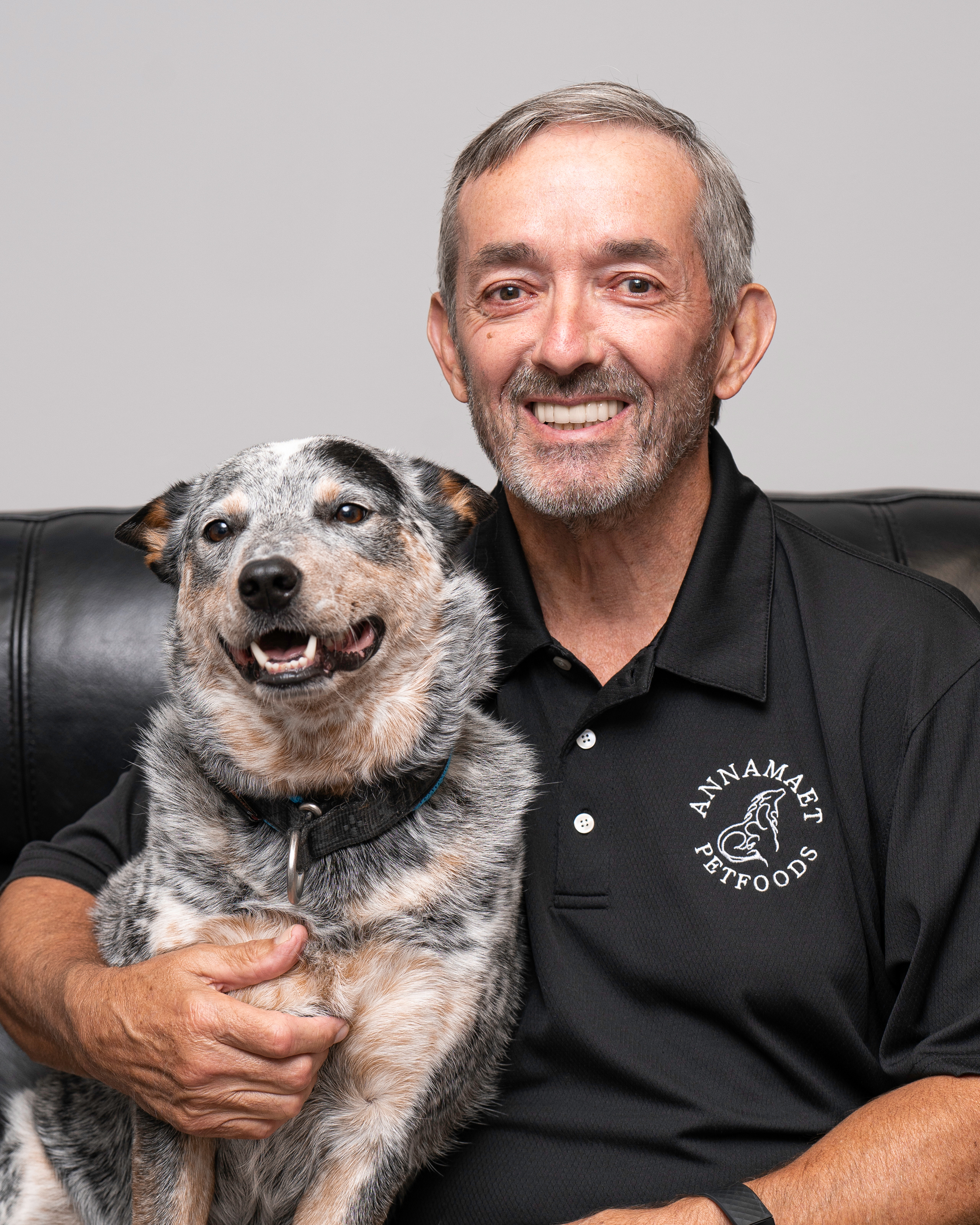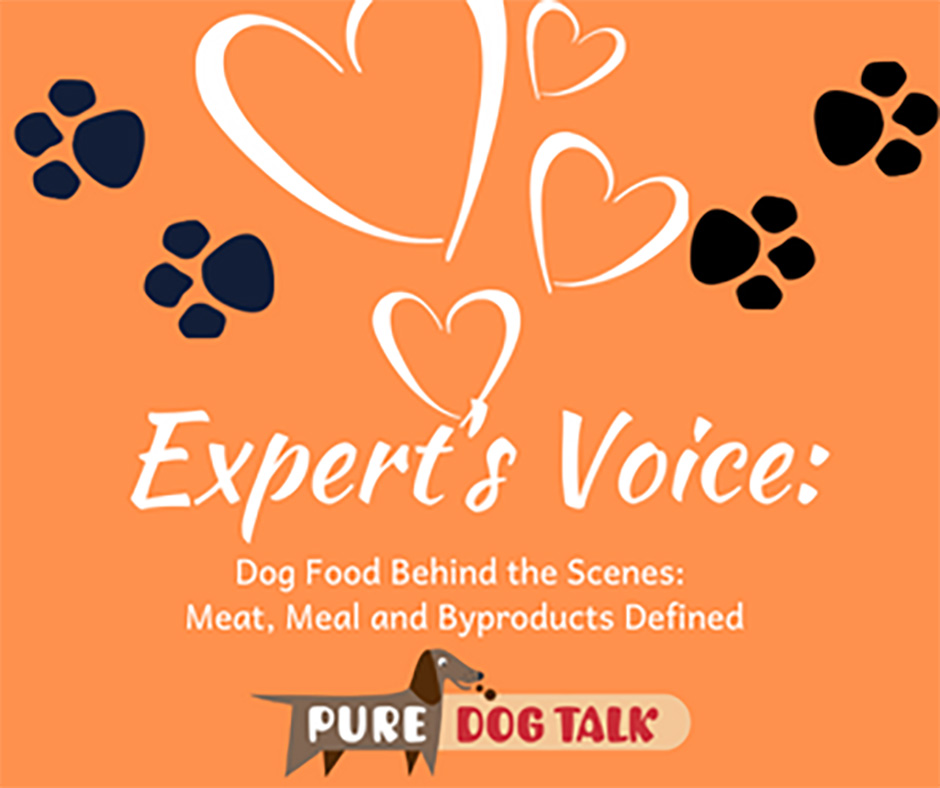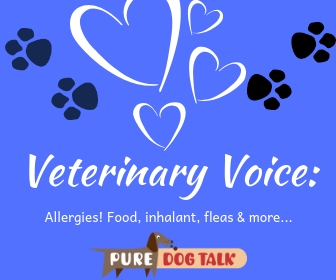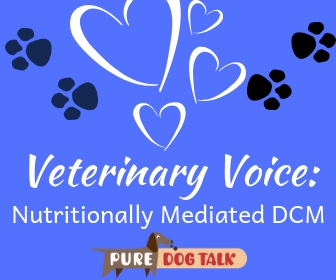572 – Dog Food Behind the Scenes: Meat, Meal and Byproducts Defined
Dog Food Behind the Scenes: Meat, Meal and Byproducts Defined
Rob Downey, nutritionist, researcher and CEO of Annamaet dogfood company, joins host Laura Reeves for a deep dive on what ingredients lists on our dog food labels mean.
“We have to back up a little bit and look at what those statements mean and where definitions come from,” Downey said. “That really comes from AAFCO. You’ll see on the package whether it be canned, frozen or whatever. AAFCO is Association of American Feed Control Officials. They don’t regulate pet foods. What they do is they set up the guidelines. And then the regulation goes through the FDA and the Department of Agriculture in most states. So AAFCO is actually a volunteer organization. Each person gets a vote, and you have to be on one of these bodies. So each state has the ability to regulate how they view it. And the sad part is, those regulations are open to the interpretation of each state official. So, every state has a feed control official. And as a pet food manufacturer, for me to sell in each state, I have to be approved by that state. So, you have to send your labels in to each individual state.
“They are the ones that determine the terminology that we’re allowed to use. And so, for example, fresh meat. If the meat you use has been frozen at any time, it’s no longer considered fresh. So as a manufacturer, I wouldn’t trust shipping non-frozen meat. What I call fresh meat, I want frozen and I’ll thaw it when I want to use it, but then I can’t attach the word fresh to it.
“Then you get into the term meal, and meal is actually a processing term where you take raw meat, and it’s heated up, moisture is removed, a lot of the fats removed and it becomes a powder and then that’s how it shipped as a meal. And then that’s also called a rendered ingredient. AAFCO is pretty strict about rendered. Anytime you change the physical component or whatever, you heat it up or you do this or do that now, it becomes a rendered product. So even in the food chain, like for instance my local meat store, if they make a sausage? If it was in the pet industry, that would be considered rendered
And the other thing that is kind of interesting, the term meal isn’t used in most parts of the world. Like if I use chicken meal, somebody in Europe, they don’t have the term meal. They would call it dehydrated chicken or simply chicken.
“Now the advantage of using a meal, is that basically the moisture has been removed. So, if I’m ordering chicken meal, a truckload, it’s only going to be 10% moisture. I’m ordering fresh chicken, a truckload is going to be 70% water, only 30% dry matter. But when you read the label. On the ingredient list, it’s according to wet weight, so it includes all that water. That’s why when you see a fresh meat formula or a meat formula, there’s always seems to be more meat ingredients, because there’s so much water. Of course, when you’re doing an extruded product that all gets kicked out.
“So chicken meal is basically skin, muscle and no internal organs. Like you can’t have organ meat in it, you can have some bone in it. But when you go to byproduct meal, that’s when the organ meat gets involved.”
Mind Blown…
When the label gives the minimum percentages of the contents (30/20 protein and fat, for example), it doesn’t have to specify the maximum, which can vary drastically from the minimum! Listen in for more insider details.
535 – Feeding Performance Dogs is All About Balance
Feeding Performance Dogs is All About Balance
 Host Laura Reeves is joined by Rob Downey, CEO of Annamaet, a companion animal nutritionist who conducted seminal research at the University of Pennsylvania on feeding performance dogs.
Host Laura Reeves is joined by Rob Downey, CEO of Annamaet, a companion animal nutritionist who conducted seminal research at the University of Pennsylvania on feeding performance dogs.
“Back in those days,” Downey said, “the idea was that you carbohydrate load (dogs) just like you do humans. We realized that that wasn’t the way to go with dogs. So, we did a study where we could actually increase stamina by 30% in running dogs by altering (the balance of) proteins, fats and carbohydrates. That has become the seminal study. It’s still cited in the NRC nutrient requirements of dogs and cats.
“We found the positive correlation between how much fat was in the diet and how far the dog could run. We found a negative correlation, a slight, very slight, negative correlation between the amount of carbohydrates and how far they could run.
“The bottom line is that any kind of long-term exercise, you’re initially burning stored carbohydrates called glycogen. That really helps you burst out of the gate or run up the hill. But once you start to use that, then these dogs, over time, become fat metabolizers. Eighty percent of the energy these dogs are using when they’re running field trials or sled dog races or more long term, they are burning fat.
“It’s an oxidative process. So, it needs oxygen. So, you need red blood cells to carry the oxygen (to the tissues) to burn the fat. That’s where the protein comes in. So, you need increased fat, you need increased protein, but you do need a minimal amount of carbohydrates to help with stool quality and “feedability.”
“You (also) need that glycogen replenishment. So that if you’re starting on day two in a trial, if you don’t have muscle glycogen stored in the body, what happens is that the dogs really don’t have any zip. They’re pretty sour or they just they don’t bounce back.
Dogs Don’t Require Ingredients, They Require Nutrients
“There’s a whole other group of studies we did on a supplement we make that actually replenishes muscle glycogen. Mother Nature is gonna replenish muscle glycogen over time but if you’re doing back to back events, you need something to replenish some muscle glycogen. So if I’m gonna work my dog today, if I use this glycogen replacement immediately post exercise, tomorrow he’s gonna have 99% of the muscle glycogen restored in the body. If I don’t use anything he’s probably only going to have 50%.
“You need the balance and you can balance out whether you’re doing kibble, raw, freeze dried or whatever. We’re talking about calories and protein, fats, carbohydrates … we haven’t even started talking about vitamins and minerals.
“There was an interesting study where they followed 2,000 beagles for about 15 years. The only thing they varied in the formulas was the vitamin levels. They had low, medium, high, and extra high. The dogs on extra-high vitamins live 23% longer than the dogs on average vitamin levels.
“They had 29% fewer veterinary visits on extra high vitamins than they did average vitamins and they were 32% less likely to have tumors. The sad part is when they went back and they examined the diets on the market, they found less than 5% of the diets had extra high vitamins.”
Tune in to hear the rest of this fascinating interview and learn from an expert on what and how to feed your dog.
324 – Veterinary Voice: Allergies! Food, Inhalant, Fleas & More
Veterinary Voice: Allergies! Food, Inhalant, Fleas & More
Food allergies are not as common as people believe, according to veterinarian Marty Greer. Inhalant, contact and flea allergies are more prevalent. Food allergy is mostly associated with chronic ear infections and recurrent skin problems. Conclusive diagnosis requires tedious food elimination diets.
“Fall is a terrible time for allergies,” Greer noted. “Especially inhalant allergies and contact allergies of pollen in the grass. You can wash the dog’s feet at night to help reduce symptoms.”
Foot chewing is the top symptom for inhalant/contact allergy, Greer said. She also observed that allergies can also be additive. A dog may have a food allergy that is only triggered by the addition of a seasonal contact allergy, for example.
It only takes one!
 Flea allergy is signaled by dogs that are itchy around the rump, Greer noted. She added that one flea bite is all it may take to set off an allergic response.
Flea allergy is signaled by dogs that are itchy around the rump, Greer noted. She added that one flea bite is all it may take to set off an allergic response.
“Flea control products today are really good. Topical or oral, they are very effective. Vacuuming regularly is an important control system for fleas,” Greer said.
Newer flea/tick control products affect the nervous system of only the parasite, Greer said. Older organophosphate-based products were not as good, she added.
Pro/Con of flea/tick preventatives
Oral meds are not recommended for patients with a history of seizures, Greer said. “They are not going to make a normal dog have a seizure. But they could trigger seizure sensitive dogs. Bravecto is the only oral medication labeled for breeding dogs,” she added.
Advantages to the oral preventatives are that they leave no residue on coat, Greer said. The advantages of topical treatments is they are not a concern in seizure sensitive patients and they make a repellant shield to biting insects. Topicals also get rid of fleas/ticks more quickly.
Anti inflammatory treatments
“In the last 10-15 years, new products have come on the market to help to replace long-term steroid use,” Greer said. “Short course steroid use is effective and the side effects are minimal.”
Links and information from Dr. Greer to learn more:
- Atopica https://www.elanco.us/products-services/dogs/atopica-cyclosporine-capsules-usp-modified Dog Quiz: https://us.atopica.com/survey-dog , Cat Quiz: https://us.atopica.com/survey-cat
- Apoquel https://www.zoetisus.com/products/dogs/apoquel/index.aspx
- Cytopoint https://www.zoetisus.com/products/dogs/cytopoint/the-itch-cycle.aspx
- Do not use APOQUEL in dogs less than 12 months of age or those with serious infections. APOQUEL may increase the chances of developing serious infections, and may cause existing parasitic skin infestations or pre-existing cancers to get worse. APOQUEL has not been tested in dogs receiving some medications including some commonly used to treat skin conditions such as corticosteroids and cyclosporine. Do not use in breeding, pregnant, or lactating dogs. Most common side effects are vomiting and diarrhea. APOQUEL has been used safely with many common medications including parasiticides, antibiotics and vaccines
- CYTOPOINT is a monoclonal antibody (mAb)* treatment for dogs that specifically targets and neutralizes canine IL-31,† an important cytokine‡ involved in sending the itch signal to the brain in chronic atopic dermatitis2
- Because it is highly targeted to a specific cytokine involved in canine atopic dermatitis, CYTOPOINT has minimal impact on normal immune functions3
- CYTOPOINT is eliminated via normal protein degradation pathways in the same way as naturally occurring antibodies; metabolism does not involve the liver or kidneys
232 – Veterinary Voice: Nutritionally Mediated Dilated Cardiomyopathy
Dog Food and Dilated Cardiomyopathy (DCM)
The UC Davis Cardiology Service has developed this document in response to the alerts from the FDA. These alerts identify an associated risk for some grain-free diets containing certain ingredients (legumes like peas, pea components, lentils; white potatoes, sweet potatoes) and a diagnosis of dilated cardiomyopathy (DCM).
Taurine Test Results Are IN – and It’s Frightful
https://www.fda.gov/AnimalVeterinary/ResourcesforYou/AnimalHealthLiteracy/ucm616279.htm
What is Dilated Cardiomyopathy (DCM)?
DCM is a heart muscle disorder that results in weak pump function and heart chamber enlargement. In the early stages of this disease, pets may appear totally healthy with no apparent clinical signs. Later in the course of this disease, dogs may have a heart murmur, an arrhythmia (irregular heartbeat), collapse episodes, weakness or tiredness with exercise, and even trouble breathing from congestive heart failure. While there are some breeds of dogs (like Dobermans) that have a genetic predisposition to the development of DCM, there are also nutritional factors that may result in this disease.
What should I do?
If you are feeding a diet of concern based upon the FDA alert we recommend that you consult with us or a veterinary cardiologist. UC Davis provides 4 general points for guidance below:
- An initial step is to consider whether you are willing or interested in performing additional testing to assess whether your pet is affected with DCM. If you believe your dog is at risk, showing any of the aforementioned clinical signs or would prefer to simply rule out any heart disease, we recommend that you first have your pet’s taurine levels tested as well as seek an echocardiogram by a board-certified veterinary cardiologist. Low taurine levels are associated with development of DCM in dogs and are sometimes a component of this current issue. Test results from dogs in our practice range from 181-347 nMol/ml. The low end is close enough to “at risk” to have us start taking action – changing diets and adding taurine.
Information on taurine testing can be found here: https://www.vetmed.ucdavis.edu/labs/amino-acid-laboratory
- At this time, diet change is recommended when possible and should be considered regardless of the results obtained from any testing. You can consult with us in selecting a new diet that avoids the ingredients of concern listed by the FDA. When selecting this diet, we recommend that you choose a diet that is manufactured with rigorous quality control measures and research behind the formulation. A way to ensure that your diet meets these recommendations is to follow the following guidelines that were generated by a large number of the world’s leading experts in veterinary nutrition. We recommend Hill’s Science Diet, Royal Canin/Iams and Purina. These companies have been producing dog food since the 1940s and do feeding trials on their food. Many newer companies only do AAFCO testing and don’t have a track record of successfully feeding dogs and cats for 70 years.
Food selection guidelines found here:
https://www.wsava.org/WSAVA/media/Arpita-and-Emma-editorial/Selecting-the-Best-Food-for-your-Pet.pdf
- If your pet is identified through testing to have a low blood taurine level or evidence of DCM by echocardiogram, we urge you to report this information to the FDA.
FDA reporting guidelines found here: https://www.fda.gov/AnimalVeterinary/SafetyHealth/ReportaProblem/ucm182403.htm
- Work with us to determine the best course of action and medical treatments if indicated. In the case of a DCM diagnosis, diet change alone may not be sufficient and additional medications may be prescribed. The current recommendation is to add GNC’s Taurine 500 mg tablets – at a dose of 1 tablet twice a day – for the next 3 to 6 months or 1000 mg twice a day for giant breed dogs.
Please continue to monitor the FDA website, www.veterinaryvillage.com and the UC Davis School of Veterinary Medicine Newsfeeds for updates and recommendations regarding this issue.
| Whole Blood nMol/ml | Whole Blood nMol/ml | |
| Normal Range | No known risk for deficiency | |
| Dog | 200-350 | >150 * |
| Cat | 300-600 | >200 * |
*Please note with recent increase in the number of dogs screened for taurine deficiency, we are seeing dogs with values within the reference ranges (or above the “no known risk for deficiency range”) yet are still exhibiting signs of cardiac disease.




